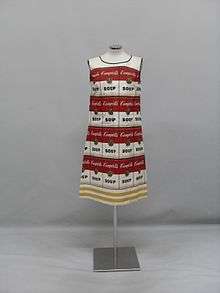Paper clothing

Paper clothing, in the form of women's dresses and other clothes made from disposable cellulose fabric, was a short-lived fashion novelty item in the United States in the 1960s.[1]
Individual paper and papier-mâché clothes and accessories (especially masquerade costumes) were used as early as the 19th century. The American Scott Paper Company developed mass-produced paper fashion in 1966 as a marketing stunt. Customers could send a coupon and $1.25 to receive a dress made of "Dura-Weve", a cellulose material patented in 1958.[1]
These "Paper Caper" dresses, which featured a red bandanna print or a black and white op art pattern, kicked off a fashion craze. 500,000 of them were produced, and other manufacturers soon followed suit. By 1967, paper dresses sold in major department stores for about $8 ($61 in 2018[2]) apiece, and entire paper clothing boutiques were set up by companies such as Abraham & Straus and I. Magnin. At the height of demand, Mars Hosiery made 100,000 dresses a week.[1] Other items made of paper included underwear, men's vests, bridal gowns (expensive at $15, or $114 in 2018[3]), children's pinafores ("just the thing for ever-sprouting sprouts") and even rain coats and bikinis ("good for two to three wearings").[4] Among the novel materials used for such clothes were "Kaycel" by Kimberly-Stevens (93% cellulose and 7% nylon, "fire resistant unless washed"), "Ree-may" by Du Pont (a "spunbonded" polyester) and "Webril" by Kendall (a nonwoven rayon).[4]
The paper dress captured the vibrant, youthful, optimistic and consumerist zeitgeist of 1960s America so precisely the fashion press speculated about paper garments taking over the entire clothes market. The dresses were whimsical, often featured eye-catching pop art-like patterns, shapes for the customer to color, or advertisements (such as the "Souper Dress" featuring Andy Warhol's "Campbell's Soup Cans"). They were just one of many newly disposable items – like cutlery, plates, pens, lighters, and razors – consumers were embracing; the "Paper Caper" sales pitch ran: "Won't last forever…who cares? Wear it for kicks—then give it the air." [1]
As the novelty appeal of paper clothes wore off, their downsides became more apparent: they were generally ill-fitting and uncomfortable, their garish colors could rub off, they were often flammable, and eventually ended as waste. By 1968, paper clothing had disappeared from the market.[1]
While no longer encountered in mass-market fashion, the same cellulose fabrics are still employed to make disposable garments for work environments, such as hospital gowns, scrubs, and coveralls. The paper dresses of the 1960s also still inspire contemporary fashion designers, including Yeohlee and Vivienne Tam, who have on occasion incorporated paper into their designs.[1]
References
- 1 2 3 4 5 6 Paton, Kathleen (2005). "Paper dresses". In Steele, Valerie. Encyclopedia of Clothing and Fashion. 3. Thomson Gale. pp. 15–16. ISBN 0-684-31394-4.
- ↑ https://data.bls.gov/cgi-bin/cpicalc.pl?cost1=15.00&year1=196701&year2=201807
- ↑ https://data.bls.gov/cgi-bin/cpicalc.pl?cost1=15.00&year1=196701&year2=201807
- 1 2 "Fashion: Real Live Paper Dolls". Time Magazine. March 17, 1967. Retrieved 5 September 2010.
Further reading
- Cunningham, P. A. & Lab, S. V (Ed.). Dress and popular culture (Popular Press, 1991) pp. 85-105.
- Walford, Jonathan (2007). Ready to tear : paper fashions of the 60s. [Fonthill, Ont.]: Kickshaw Productions. ISBN 0978223004.
- Zidianakis, Vassilis (2007). Rrripp!! Paper Fashion. ATOPOS Foundation. ISBN 978-960-89637-1-9.
External links
![]()
- Paper Dresses of the 1960s from Collector's Guide To Vintage Fashions: the 1950s & 60s